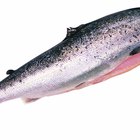Joanna_Tully/iStock/GettyImages
The Chilean sea bass really isn’t a bass at all, but rather a fish with a less appetizing-sounding name: the Patagonian Toothfish. Despite its name and fearsome, pointy teeth, the Chilean sea bass is prized for its firm, oily texture and excellent flavor. The cheeks of the Chilean sea bass are considered a delicacy with a flavor akin to that of scallops. Lightly poach or gently grill the cheeks and serve alongside a lovely butter sauce for a succulent, savory meal.
Steamed Chilean Sea Bass Cheeks
Soak the fish cheeks in a bowl of chilled, lightly salted water for approximately 5 minutes.
Rinse the fish cheeks under cold, running water and pat dry with paper towels. Bring a pot with a few inches of water inside to a simmer. Place the fish cheeks in a steamer basket and into the pot of simmering water, making sure the basket sits above the water.
Put a lid on the pot and gently steam the fish cheeks for around 5 minutes. Remove the fish cheeks from the pot and serve immediately with a butter sauce. Alternatively, if you plan on using the fish cheeks in another dish, briefly submerge them in cold water to halt the cooking process.
Grilled Chilean Sea Bass Cheeks
Preheat your grill to a low heat.
Prepare a simple sauce for your fish cheeks to cook in by melting a few tablespoons of butter over medium-high heat in a pan on the stove top. Add seasonings such as salt and pepper, chives, dill, lemon juice, white wine and minced shallot and garlic, if desired. Saute for 3 to 4 minutes and remove from heat. Let cool.
Tear off a sheet of aluminum foil and spoon some of the sauce onto it. Arrange the fish cheeks in a single layer on top of the sauce. Pour additional sauce over the top of the fish cheeks and wrap the foil tightly around them to create a foil packet. If you are preparing a large number of fish cheeks you may want to create more than one foil packet.
Place the packets on the grill, grilling for approximately 3 minutes on each side. Remove the foil packets from the grill and serve the fish cheeks with the butter sauce ladled over them.
Related Articles

How to Cook Salmon Cheeks

How to Cook Angelfish

How to Cook Rockfish Fillets

How to Steam Codfish

How to Bake Lingcod

How to Bake Boneless Skinless Tilapia
How to Cook Salmon to Moist & Tender ...

How to Grill a Cod Fish

How to Pan Fry Grouper
How to Cook a Turbot in the Oven

How to Pan Sear Sea Bass
How to Cook Seasoned Keta Salmon

How to Cook Sea Trout

How to Cook Tilefish

How to Cook Sculpin Fish

How to Cook Belt Fish

How to Cook Whole Butterfish

How to Pan-Sear Swordfish

How to Boil Conch in the Shell

How to Cook Eelpout
References
- Great British Chefs: Pan-Fried Sea Bass, Butter Spinach, Clams, Poached Cod Cheeks and Fish Sauce
- Fish and Shellfish: The Cook's Indispensable Companion; James Peterson
Tips
- Finding Chilean sea bass cheeks is no easy feat; check at your local grocer's meat counter, ask your local fishmonger or try ordering them online. If you’re unable to locate them, substitute cod or halibut cheeks, which are more readily available..
- Chilean sea bass cheeks have a light, delicate flavor so pair them with delicate side dishes like steamed asparagus, rice pilaf or a fresh garden salad.
Writer Bio
Christina Kalinowski is a writer from the Twin Cities who began her career in 2011. She contributes food and drink related articles to The Daily Meal. She holds a Master of Arts in sociology from Purdue University.